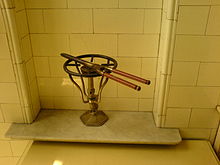This is an old revision of this page, as edited by Calliopejen~enwiki (talk | contribs) at 04:43, 20 March 2007. The present address (URL) is a permanent link to this revision, which may differ significantly from the current revision.
Revision as of 04:43, 20 March 2007 by Calliopejen~enwiki (talk | contribs)(diff) ← Previous revision | Latest revision (diff) | Newer revision → (diff)You must add a |reason= parameter to this Cleanup template – replace it with {{Cleanup|January 2007|reason=<Fill reason here>}}, or remove the Cleanup template.
| This article does not cite any sources. Please help improve this article by adding citations to reliable sources. Unsourced material may be challenged and removed. Find sources: "Hair iron" – news · newspapers · books · scholar · JSTOR (November 2006) (Learn how and when to remove this message) |

A hair iron or hair tong is a tool used to change the structure of the hair with the help of heat. There are two general kinds: Straightening irons, used to straighten the hair, and curling irons, used to make the hair curly. Straightening irons may also be called flat irons, but not to be confused with clothes flat irons.
History of hair straightening methods
Hair straighteners work by breaking down the hair's hydrogen bonds, which cause hair to bend and become curly. Once the bonds are broken, hair is prevented from holding its original, natural form.
The first hair straightener was invented by Ian Gutgold using harsh chemicals in lotions applied to the hair and scalp. However, these preparations often led to scorched scalps and damaged hair.
Simon E. Monroe patented a hair straightener in 1906 that was comprised of metallic teeth that are combed through the hair, while in 1909 Issac K. Shero patented a hair straightener comprised of two flat irons that are heated and pressed together.
Years later, Sharrell invented heated metal hair-care implements, such as hot combs. The hot metal straightener slid easily through the hair, causing less damage and dryness than previously-used techniques. Later, ceramic and electrical straighteners were introduced, allowing for adjustment of heat settings and straightener size.
Another method of hair straightening is the thermal Japanese hair straightening technique, which acts as a sort of "anti-perm". It is now available at many salons but is quite expensive and must be repeated on a regular basis.
Modern hair straighteners
Less expensive brands of hair straighteners do not have ceramic heating elements. Some may claim to have ceramic plates when in actuality they only have a paint-like coating on the plates to give the appearance of a more expensive ceramic straightener. The cheaper models do more damage to the hair and are less effective. Higher quality irons, such as those used in salons, use true ceramic coated plates and ceramic heaters for full heat up in as little as 7 seconds.
A number of products may be used to stop the hair from drying out when it is straightened. Straightening may cause split ends and thinning of the hair. It may also make the hair appear damaged and unhealthy after long periods of use.
Hair straighteners should only be used on dry hair, unless they are specially made with vents to let the moisture out. These sort of "special" irons are usually called "Wet Dry" irons.
Hair straighteners are not difficult to find and are found in many stores. Some work well, but can usually damage hair. The straighteners that do not damage hair may cost a great deal of money. These straighteners are usually used by hair stylists. The picture to the right is of a more expensive iron, the T3 Tourmaline Ionic Hair Iron.
Straightener brands
References
See also
External Links
- "Hair Straightener - LoveToKnow Hair".
- Melissa B. Read. "Designing a better hair straightener" (PDF).
Understanding the problem: What makes hair straight?